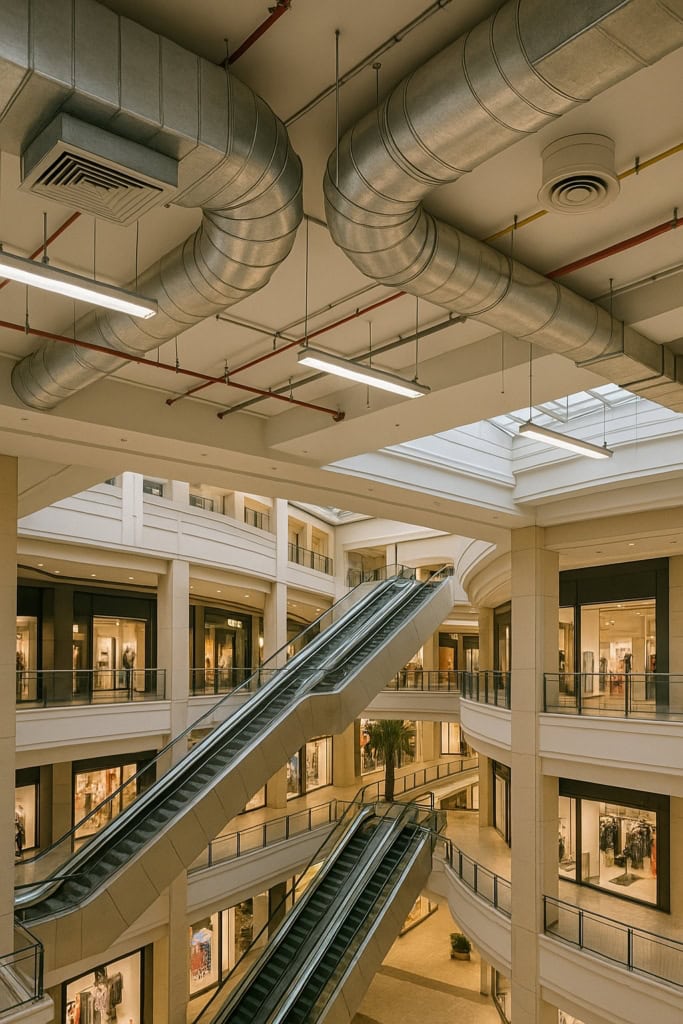When shoppers wander from ground-level boutiques to rooftop cinemas, they barely notice the hidden network of chillers, fans, and sensors that keeps every corner comfortable. Engineers, however, confront a vertical maze of heat gains, pressure losses, and space constraints that turns a mall into one of HVAC’s most demanding classrooms.
Knowing those obstacles—and planning for them early—is the first step toward keeping escalators busy, energy bills manageable, and tenants happy.
Diverse Microclimates on Every Floor
A glass-roofed atrium bathed in tropical sunlight demands steady cooling, while a basement supermarket favors crisp, low-humidity air that preserves produce. Add a third-floor arcade packed with heat-spewing game cabinets, and you suddenly have three climates in one envelope.
Designers rely on variable air-volume boxes, dedicated outdoor-air systems, and zoned controls to fine-tune supply conditions minute by minute. Even so, a lunchtime wave of diners from the food court can spike sensible heat, forcing sensors and dampers to rebalance the stack again and again, swiftly.
Long Duct Runs and Static Pressure Loss
Architectural flourishes—vaulted ceilings, sweeping atria, ornamental bridges—stretch ductwork like an interstate highway riddled with elbows, branches, and elevation changes. As conditioned air travels hundreds of feet, static pressure bleeds away, and distant diffusers starve.
Oversizing fans recovers flow but punishes the utility budget with noise and vibration. Instead, engineers model every run in software, tweaking diameters, lining materials, and turning vanes so a perfume kiosk on level five receives the same gentle breeze enjoyed by anchor stores below, without spiking amperage during sales-season peaks, too.
Tenant Turnover and Unpredictable Heat Loads
Lease agreements flip faster than mechanical infrastructure can. Yesterday’s quiet bookstore may become a sizzling teppanyaki grill that quadruples sensible heat overnight. Forward-thinking owners build extra tonnage into chilled-water loops, reserve breaker space for future condensers, and specify flexible risers with quick-connect valves.
Those allowances let contractors perform 2 a.m. retrofits without shutting down an entire wing, yet the facilities team still plays scheduling chess to ensure new tenants plug in without tripping breakers or starving neighboring zones of chilled water during grand-opening holiday rushes, too.
Water Management and Vertical Equipment Logistics
Cooling towers perched on the roof must feed condensers several stories below, while condensate drains race back up to reach a plumbing stack. A properly sized inline booster pump overcomes elevation head without overstressing decades-old copper and protects coils from cavitation.
Moving bulky air-handling units through narrow service elevators requires sectionalized casings that can be wheeled in pieces and reassembled beside tower sinks, all while keeping emergency egress corridors clear for shoppers and fire-code inspections, even on stormy weekends when freight access is heavily booked.
Conclusion
A mall may feel like one seamless environment to visitors, but behind its storefronts hums an ecosystem of ducts, pumps, and code algorithms battling gravity, glass façades, and changing tenants. By anticipating vertical headaches—microclimates, pressure losses, turnover, and water logistics—facility teams not only slash energy bills but also deliver the invisible, temperature-perfect shopping experience patrons now expect every day.





Leave a Reply